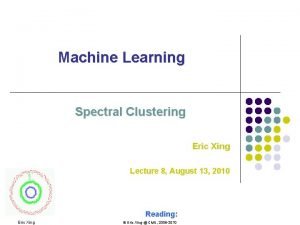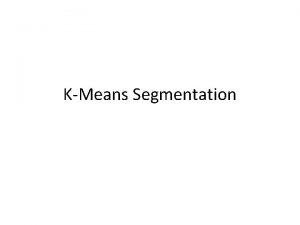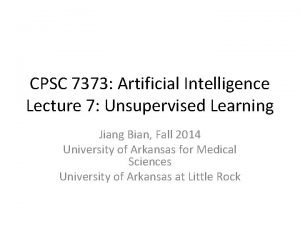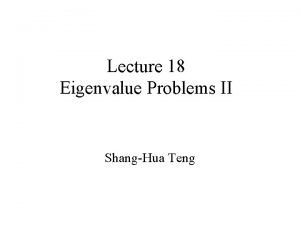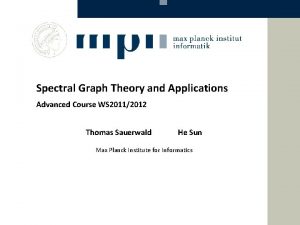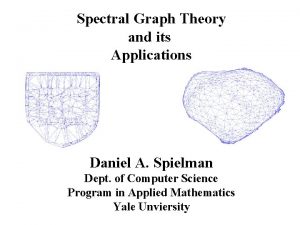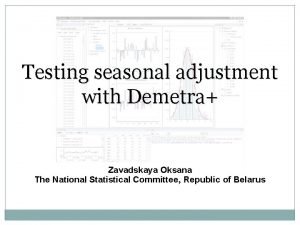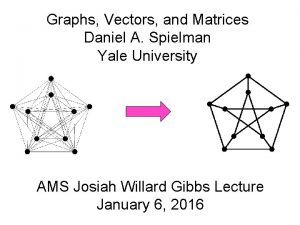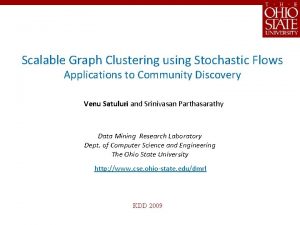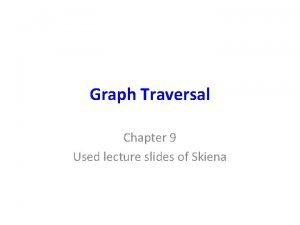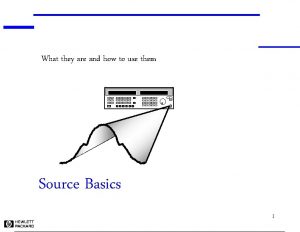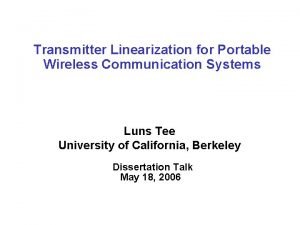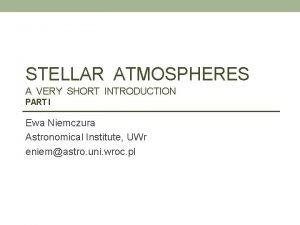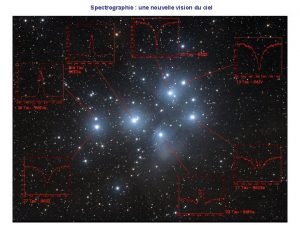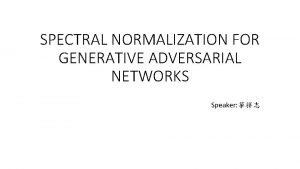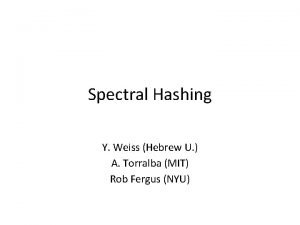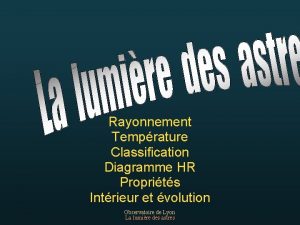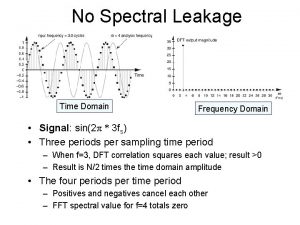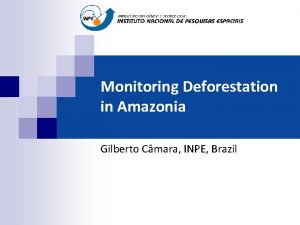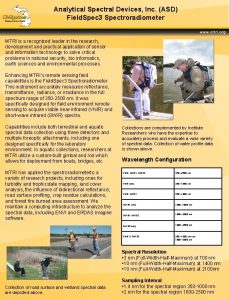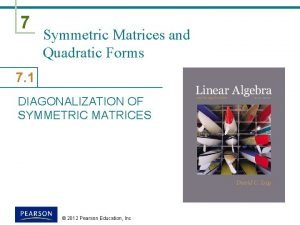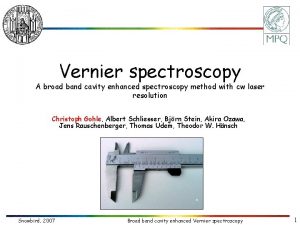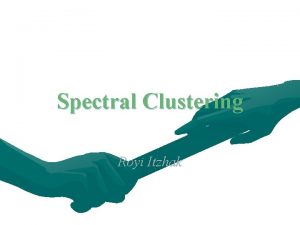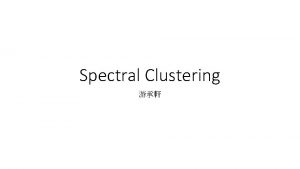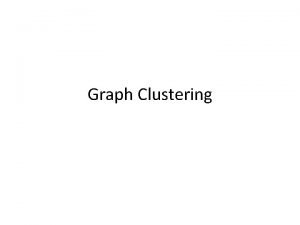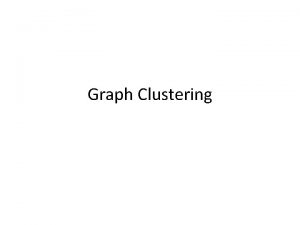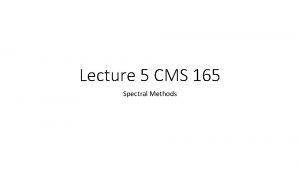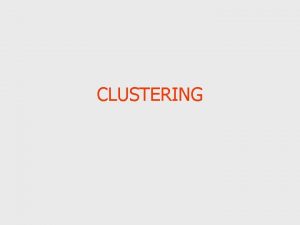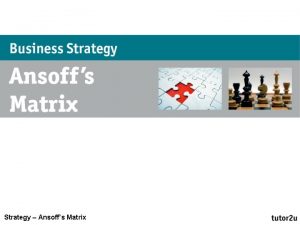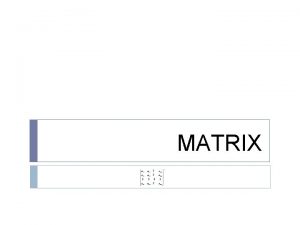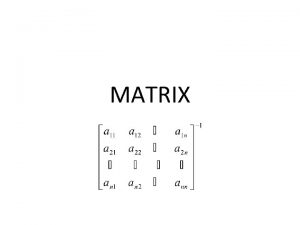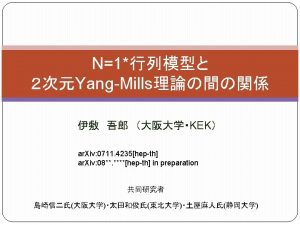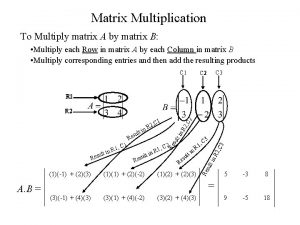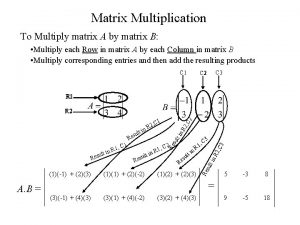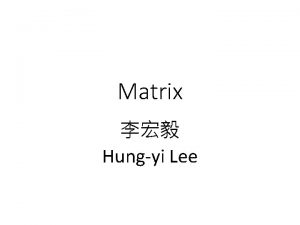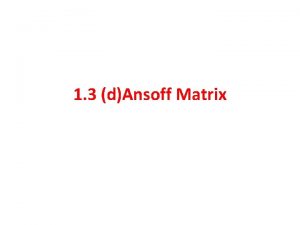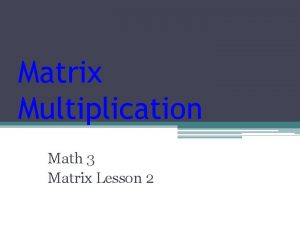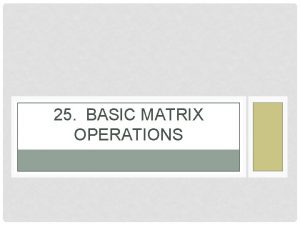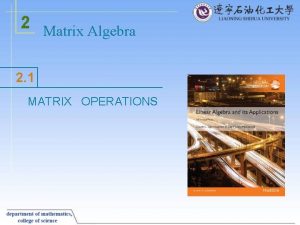Spectral clustering methods Spectral Clustering Graph Matrix A




























- Slides: 28

Spectral clustering methods

Spectral Clustering: Graph = Matrix A A B C 1 1 C D B D E 1 G H I C 1 1 1 B 1 A 1 1 H 1 I 1 1 1 1 D G I 1 G J J 1 E F F J F E H

Spectral Clustering: Graph = Matrix Transitively Closed Components = “Blocks” A B C A _ 1 1 B 1 _ 1 C 1 1 _ D E F _ 1 1 E 1 _ 1 1 1 _ G 1 I J C 1 D F G H B _ 1 1 H _ 1 1 I 1 1 _ 1 J 1 1 1 _ D A G I J F E Of course we can’t see the “blocks” unless the nodes are sorted by cluster… H

Spectral Clustering: Graph = Matrix Vector = Node Weight v M A B C A _ 1 1 B 1 _ C 1 1 D E F G H I J 1 A A 3 1 B 2 _ C 3 D _ 1 1 D E 1 _ 1 E 1 1 _ F F G 1 _ H 1 1 G _ 1 1 H I 1 1 _ 1 I J 1 1 1 _ J M C B D A G I J F E H

Spectral Clustering: Graph = Matrix M*v 1 = v 2 “propogates weights from neighbors” A B C A _ 1 1 B 1 _ C 1 1 D E F G M * v 1 = v 2 H I J 1 A 3 1 B 2 _ C 3 D _ 1 1 D E 1 _ 1 E F 1 1 _ F G _ H 1 1 G _ 1 1 H I 1 1 _ 1 I J 1 1 1 _ J A 2*1+3*1+0* 1 B 3*1+3*1 C 3*1+2*1 D E F G H I M J C B D A F E

Spectral Clustering: Graph = Matrix W*v 1 = v 2 “propogates weights from neighbors” W: normalized so columns sum to 1 A B C A _ . 5 B . 3 _ . 5 C . 3 . 5 D E F G H W * v 1 = v 2 I J . 3 _ A 3 B 2 C 3 D D _ . 5 . 3 E E . 5 _ . 3 F . 5 _ F G . 3 G H _ H . 3 I _ . 3 J I . 5 _ . 3 J . 5 . 3 _ A 2*. 5+3*. 5+0*. 3 B 3*. 3+3*. 5 C 3*. 33+2*. 5 D E F G H I J C B D A F E

Spectral Clustering • Suppose every node has a value (IQ, income, . . ) y(i) – Each node i has value yi … • and neighbors N(i), degree di – If i, j connected then j exerts a force -K*[yi-yj] on i – Total: – Matrix notation: F = -K(D-A)y • D is degree matrix: D(i, i)=di and 0 for i≠j • A is adjacency matrix: A(i, j)=1 if i, j connected and 0 else – Interesting (? ) goal: set y so (D-A)y = c*y

Spectral Clustering • Suppose every node has a value (IQ, income, . . ) y(i) – Matrix notation: F = -K(D-A)y • D is degree matrix: D(i, i)=di and 0 for i≠j • A is adjacency matrix: A(i, j)=1 if i, j connected and 0 else – Interesting (? ) goal: set y so (D-A)y = c*y – Picture: neighbors pull i up or down, but net force doesn’t change relative positions of nodes

Spectral Clustering: Graph = Matrix W*v 1 = v 2 “propogates weights from neighbors” • smallest eigenvecs of D-A are largest eigenvecs of A • smallest eigenvecs of I-W are largest eigenvecs of W Q: How do I pick v to be an eigenvector for a blockstochastic matrix?

Spectral Clustering: Graph = Matrix W*v 1 = v 2 “propogates weights from neighbors” How do I pick v to be an eigenvector for a blockstochastic matrix?

Spectral Clustering: Graph = Matrix W*v 1 = v 2 “propogates weights from neighbors” • smallest eigenvecs of D-A are largest eigenvecs of A • smallest eigenvecs of I-W are largest eigenvecs of W Suppose each y(i)=+1 or -1: • Then y is a cluster indicator that splits the nodes into two • what is y. T(D-A)y ?

= size of CUT(y) NCUT: roughly minimize ratio of transitions between classes vs transitions within classes

Spectral Clustering: Graph = Matrix W*v 1 = v 2 “propogates weights from neighbors” • smallest eigenvecs of D-A are largest eigenvecs of A • smallest eigenvecs of I-W are largest eigenvecs of W Suppose each y(i)=+1 or -1: • Then y is a cluster indicator that cuts the nodes into two • what is y. T(D-A)y ? The cost of the graph cut defined by y • what is y. T(I-W)y ? Also a cost of a graph cut defined by y • How to minimize it? • Turns out: to minimize y. T X y / (y. Ty) find smallest eigenvector of X • But: this will not be +1/-1, so it’s a “relaxed” solution

Spectral Clustering: Graph = Matrix W*v 1 = v 2 “propogates weights from neighbors” λ 1 e 1 λ 2 e 3 λ 3 “eigengap” λ 4 e 2 λ 5, 6, 7, …. [Shi & Meila, 2002]

Spectral Clustering: Graph = Matrix W*v 1 = v 2 “propogates weights from neighbors” e 2 0. 4 0. 2 xxxxxx xxx 0. 0 -0. 2 yyyy zzzzzz zz zz e 1 y -0. 4 -0. 2 0 0. 2 [Shi & Meila, 2002] M e 3 e 2


Books

Football

Not football (6 blocks, 0. 8 vs 0. 1)

Not football (6 blocks, 0. 6 vs 0. 4)

Not football (6 bigger blocks, 0. 52 vs 0. 48)

Some more terms • If A is an adjacency matrix (maybe weighted) and D is a (diagonal) matrix giving the degree of each node – Then D-A is the (unnormalized) Laplacian – W=AD-1 is a probabilistic adjacency matrix – I-W is the (normalized or random-walk) Laplacian – etc…. • The largest eigenvectors of W correspond to the smallest eigenvectors of I-W – So sometimes people talk about “bottom eigenvectors of the Laplacian”

A W K-nn graph (easy) Fully connected graph, weighted by distance

Spectral Clustering: Graph = Matrix W*v 1 = v 2 “propogates weights from neighbors” e 2 0. 4 0. 2 xxxxxx xxx 0. 0 -0. 2 yyyy zzzzzz zz zz e 1 y -0. 4 -0. 2 0 [Shi & Meila, 2002] 0. 2 e 3 e 2

Spectral Clustering: Graph = Matrix W*v 1 = v 2 “propagates weights from neighbors” If Wis connected but roughly block diagonal with k blocks then • the top eigenvector is a constant vector • the next k eigenvectors are roughly piecewise constant with “pieces” corresponding to blocks M

Spectral Clustering: Graph = Matrix W*v 1 = v 2 “propagates weights from neighbors” If W is connected but roughly block diagonal with k blocks then • the “top” eigenvector is a constant vector • the next k eigenvectors are roughly piecewise constant with “pieces” corresponding to blocks M Spectral clustering: • Find the top k+1 eigenvectors v 1, …, vk+1 • Discard the “top” one • Replace every node a with k-dimensional vector xa = <v 2(a), …, vk+1 (a) > • Cluster with k-means

Spectral Clustering: Pros and Cons • Elegant, and well-founded mathematically • Works quite well when relations are approximately transitive (like similarity) • Very noisy datasets cause problems – “Informative” eigenvectors need not be in top few – Performance can drop suddenly from good to terrible • Expensive for very large datasets – Computing eigenvectors is the bottleneck

Experimental results: best-case assignment of class labels to clusters Eigenvectors of W Eigenvecs of variant of W
 Eric xing
Eric xing Spectral clustering
Spectral clustering Spectral clustering
Spectral clustering Flat and hierarchical clustering
Flat and hierarchical clustering Divisive hierarchical clustering example
Divisive hierarchical clustering example Flat clustering vs hierarchical clustering
Flat clustering vs hierarchical clustering Spectral decomposition
Spectral decomposition Spectral graph theory and its applications
Spectral graph theory and its applications Daniel spielman spectral graph theory
Daniel spielman spectral graph theory Spectral graph
Spectral graph Spectral graph theory spielman
Spectral graph theory spielman Graclus
Graclus Direct wax pattern
Direct wax pattern Graph traversal methods
Graph traversal methods Spectral regrowth
Spectral regrowth Spectral regrowth
Spectral regrowth Spectral classification
Spectral classification Profil spectral rigel
Profil spectral rigel Spectral normalization for generative adversarial networks
Spectral normalization for generative adversarial networks Spectral hashing
Spectral hashing Spectral efficiency
Spectral efficiency Domaine spectral
Domaine spectral Spectral leakage
Spectral leakage Spectral bands
Spectral bands Video spectral comparator
Video spectral comparator Spectral characteristics of angle modulated signals
Spectral characteristics of angle modulated signals Analytical spectral devices
Analytical spectral devices Spectral decomposition
Spectral decomposition Vernier spectral analysis
Vernier spectral analysis
